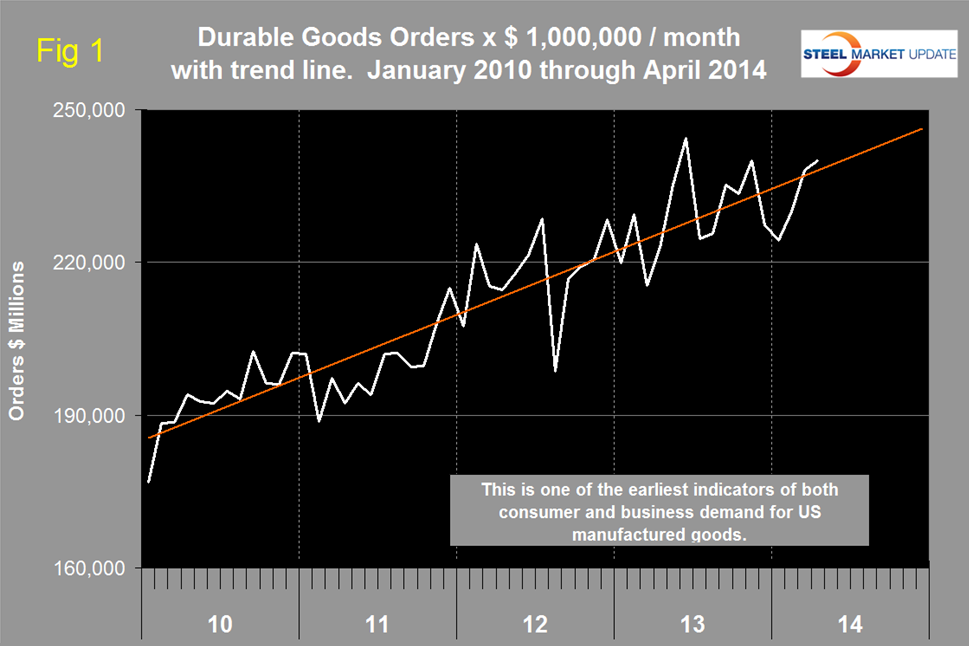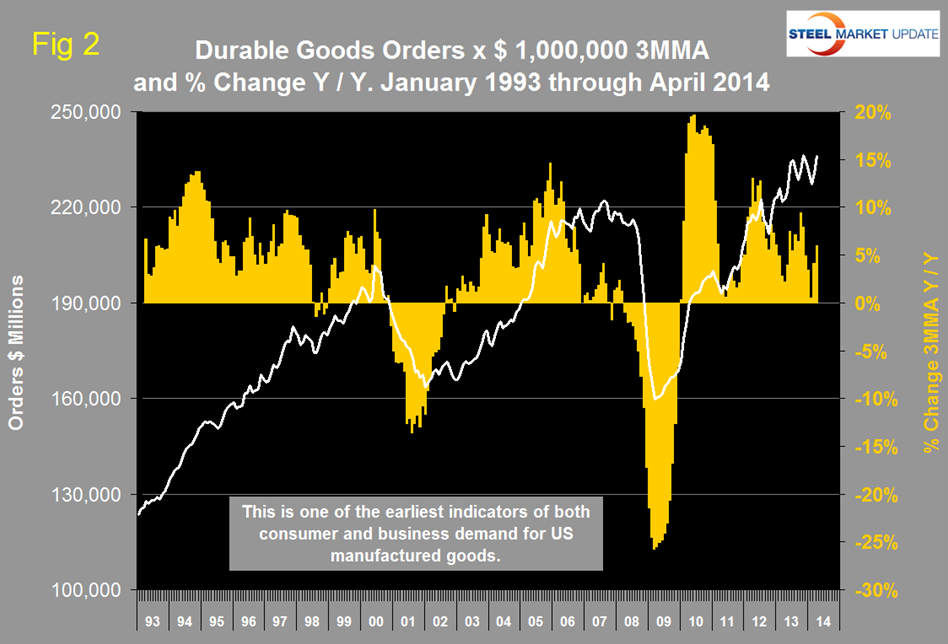Economy

Durable Goods Saw New Orders Increase
Written by Peter Wright
May 27, 2014
Durable Goods, a measure of the health of the steel industry, saw new orders increase for the fourth consecutive month in April ,continuing the healthy trend that has existed since the recession. Both March and April were above trend, (Figure 1).
The three month moving average (3MMA) increased in both March and April, (Figure 2). The year over year growth rate of the 3MMA grew at six percent, its best performance since November.
Moody’s Economy.com reported as follows: “The April durable goods report beat expectations, but the underlying details were mixed. New orders for defense aircraft drove gains, as ex-defense orders fell 0.8 percent and ex-transportation orders increased by a modest 0.1 percent. Motor vehicle and non-defense aircraft orders declined, as did orders for machinery and computers/electronics.
“Capital equipment spending by businesses has been trending north for most reported industrial segments, and 2014 will shape up to be a good year for investment if the current pattern holds. Core capital goods shipments are key source data used by the government to estimate equipment spending in the GDP accounts, and the latest data suggest a pickup in real equipment spending growth after the lull in the third quarter. Capital investment is essential to long-term growth.
Stabilizing equipment purchases are good for growth in coming years, and firms are getting back to the pace of investment that prevailed in the middle of last year. Moreover, manufacturers added to payrolls in April, and fundamentals favor additional investment and hiring in the coming months.”
The Census Bureau press release issued today read as follows:
“New orders for manufactured durable goods in April increased $1.9 billion or 0.8 percent to $239.9 billion, the U.S. Census Bureau announced today. This increase, up three consecutive months, followed a 3.6 percent March increase. Excluding transportation, new orders increased 0.1 percent. Excluding defense, new orders decreased 0.8 percent. Transportation equipment, also up three consecutive months, led the increase, $1.7 billion or 2.3 percent to $76.9 billion.
“Shipments of manufactured durable goods in April, down following two consecutive monthly increases, decreased $0.6 billion or 0.2 percent to $237.2 billion. This followed a 1.3 percent March increase. Transportation equipment, down following three consecutive monthly increases, drove the decrease, $0.7 billion or 1.0 percent to $69.5 billion.
“Unfilled orders for manufactured durable goods in April, up twelve of the last thirteen months, increased $10.4 billion or 1.0 percent to $1,081.0 billion. This was at the highest level since the series was first published on a NAICS basis in 1992, and followed a 0.8 percent March increase. Transportation equipment, up seven of the last eight months, led the increase, $7.5 billion or 1.1 percent to $671.7 billion.
“Inventories of manufactured durable goods in April, up twelve of the last thirteen months, increased $0.3 billion or 0.1 percent to $393.3 billion. This was at the highest level since the series was first published on a NAICS basis, and followed a 0.2 percent March increase. Transportation equipment, also up twelve of the last thirteen months, drove the increase, $0.3 billion or 0.3 percent to $126.1 billion.
“Nondefense new orders for capital goods in April decreased $0.8 billion or 1.0 percent to $82.2 billion. Shipments decreased $0.4 billion or 0.6 percent to $76.5 billion. Unfilled orders increased $5.7 billion or 0.9 percent to $656.1 billion. Inventories increased $0.5 billion or 0.3 percent to $178.6 billion. Defense new orders for capital goods in April increased $3.6 billion or 39.3 percent to $12.9 billion. Shipments increased $0.1 billion or 1.4 percent to $9.6 billion. Unfilled orders increased $3.3 billion or 2.1 percent to $159.6 billion. Inventories decreased $0.3 billion or 1.2 percent to $23.6 billion.
“Revised March Data. Revised seasonally adjusted March figures for all manufacturing industries, based on updated seasonal adjustment models, were: new orders, $495.9 billion (revised from $493.9 billion); shipments, $495.7 billion (revised from $494.9 billion); unfilled orders, $1,070.5 billion (revised from $1,069.3 billion); and total inventories $643.0 billion (revised from $643.1 billion).”

Peter Wright
Read more from Peter WrightLatest in Economy

Architecture billings continue to slide in March
Architecture firms said billings continued to decline in March, according to the latest Architecture Billings Index (ABI) released by the American Institute of Architects (AIA) and Deltek.

Beige Book shows concerns about trade policy
Manufacturing was mixed, but two-thirds of districts said activity was little changed or had declined.

New York state manufacturing index drops again in April
Firms were pessimistic, with the future general business conditions index falling to its second lowest reading in the more than 20-year history of the survey

Construction adds 13,000 jobs in March
The construction sector added 13,000 jobs, seasonally adjusted, in March, but tariffs could undermine the industry.

Supply chains, end-users brace for impact from tariffs
Supply chains are working through what the tariffs mean for them


